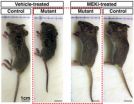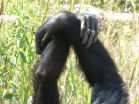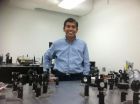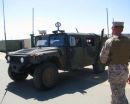(Press-News.org) ANN ARBOR, Mich. — A drug originally developed to stop cancerous tumors may hold the potential to prevent abnormal brain cell growth and learning disabilities in some children, if they can be diagnosed early enough, a new animal study suggests.
The surprising finding sets the stage for more research on how anti-tumor medication might be used to protect the developing brains of young children with the genetic disease neurofibromatosis 1 -- and other diseases affecting the same cellular signaling pathway.
The findings, made in mice, are reported in the journal Cell by scientists at the University of Michigan Medical School and their colleagues. The results are also important to understanding the stem cells that become different brain cells.
Neurofibromatosis 1, or NF1, affects one in every 3,000 children, and causes benign tumors to grow throughout the body, large head size and other issues. Many children with NF1 also struggle with learning to read, write, do math and behave well.
This impact on brain function is considered the most common serious issue caused by NF1, and often appears before other symptoms, except for brown patches on the skin that are often mistaken for birthmarks. But while the tumors that erupt mostly later in life have been well-studied, NF1's effect on brain function isn't understood.
In the new paper, the team studied neural stem cells – a kind of master cell that can become any type of neural tissue. In newborn mice with two copies of the genetic mutation that causes NF1, neural stem cells in a key area of the brain were far more likely to produce a kind of "helper" nerve cell called glia. They produced far fewer cells called neurons, which send and receive crucial signals in the brain and body.
The scientists then took aim at this abnormal cell growth by giving the mice an experimental drug that has already been used in clinical trials for advanced cancer. Called PD0325901, the drug blocks a specific action within cells called the MEK/ERK pathway. It's one of a class of drugs known as MEK inhibitors.
Mice with the NF1 mutation that got the drug from birth developed normally – in stark contrast to mice with the same genetic mutations that didn't receive the drug. The untreated mice appeared normal at birth, but within a few days had become hunched and scruffy, with abnormal growth of their bodies and brain cells.
The new paper's senior author, Yuan Zhu, Ph.D., cautions that the particular drug in the trial may not be appropriate to give to children who have been diagnosed with NF1. But other MEK inhibitors are being developed against cancer.
"The important thing is that we have shown that by treating during this brief window of time early in life, when neural stem cells in a developing brain still have time to 'decide' what kind of cell to become, we can cause a lasting effect on neural development," he says. Zhu is an associate professor of internal medicine, in the Division of Molecular Medicine and Genetics, and in the Department of Cell & Developmental Biology, at the Medical School.
The scientists didn't study the drug's effect on the behavior or learning ability of the mice, nor their tendency to develop benign brain tumors that can occur in NF1. In order for any such drug-based intervention to work most effectively, he notes, it would have to be given soon after developmental delays or benign tumors are noted in an infant or toddler, and after a NF1 diagnosis is made.
About half of all people with NF1 inherited the mutated gene from a parent, while about half developed it spontaneously in the womb. The disease affects individual patients very differently -- one child born to a parent with mild NF1 can have a severe form of the disease, while their siblings can have mild or moderate symptoms.
Some people with NF1 have a "double hit" form of the disease, where both copies of the gene are mutated in certain body cells. The second mutation, the scientists say, likely occurs in a neural stem cell that goes on to produce unusual neural cells. These patients often have severe learning disabilities, and an enlarged corpus callosum -- a structure that connects the two halves of the brain and contains a large concentration of glia, the same cells that the mice in the new study had larger numbers of.
In addition to NF1, the researchers predict that their findings may have importance for patients with other genetic conditions that affect the same general cell-signaling pathway called RAS. Collectively called neuro-cardio-facial-cutaneous (NCFC) syndromes or ''RASopathies", they include Leopard syndrome, Noonan syndrome, Costello syndrome and Leguis syndrome – all of which, like NF1, affect the brains, circulation system and the face or head.
The new research is based on several other discoveries made by current or former U-M faculty. The gene for NF1 was discovered in the late 1980s by Francis Collins, M.D., Ph.D. when he was a faculty member at the U-M Medical School, together with colleagues from other institutions. Collins is now director of the National Institutes of Health. That discovery paved the way for a genetic test that can now help definitively diagnose children with NF1, and guide their treatment.
Judith Sebolt Leopold, Ph.D., a research associate professor of radiology at the U-M Medical School, was a key member of the research team that developed PD0325901 while she worked at the Pfizer Research Laboratory formerly located in Ann Arbor.
The drug was first used in a cancer clinical trial in 2005, which was stopped when side effects on the retinas of some participants' eyes were noted. A new trial, using the drug in combination with another one, and comparing that combination with another drug combination, is now under way. Other MEK inhibitors, or MEKi drugs, are also in testing around the world, as scientists zero in on the RAS pathway as an important player in all kinds of cancer including melanoma.
INFORMATION:
In addition to Zhu, the research team includes U-M postdoctoral research fellow and former Zhu graduate student Yuan Wang, Ph.D.; Edward Kim, B.S.; former postdoctoral research fellow Xiaojing Wang, Ph.D.; and colleagues from other institutions Bennett G. Novitch, Kazuaki Yoshikawa and Long-Sheng Chang.
Reference: Cell, Volume 150, Issue 4, 816-830, 17 August 2012
Funding: NIH (1R01 NINDS NS053900) and DOD (W81XWH-11-1-0251)
Neurofibromatosis testing is available from the Pediatrics Genetics clinic at the U-M C.S. Mott Children's Hospital. Visit mottchildren.org/medical-services/ped-genetics or call 734-764-0579.
Could a cancer drug potentially prevent learning disabilities in some kids?
U-M scientists stop abnormal brain cell growth in mice with neurofibromatosis using experimental tumor drug, make new discoveries in neural stem cells
2012-08-29
ELSE PRESS RELEASES FROM THIS DATE:
Belimumab for lupus erythematosus: Added benefit not proven
2012-08-29
Belimumab (trade name Benlysta ®) has been approved since July 2011 as an add-on therapy for adult patients with the autoimmune disease systemic lupus erythematosus (SLE). This monoclonal antibody is only considered as treatment when the disease is still active in spite of standard therapy. The German Institute for Quality and Efficiency in Health Care (IQWiG) has now examined the added benefit of this drug pursuant to the Act on the Reform of the Market for Medicinal Products (AMNOG).
According to the findings, there is no proof that belimumab provides added benefit ...
Mount Sinai researchers solve mystery surrounding the death of two sisters nearly 50 years ago
2012-08-29
Researchers at Mount Sinai School of Medicine have identified the genetic cause of a rare and fatal bone disease by studying frozen skin cells that were taken from a child with the condition almost fifty years ago. Their study, which details how the MT1-MMP gene leads to the disease known as Winchester syndrome, appears in the August 23, 2012 online edition of The American Journal of Human Genetics.
In 1969, Patricia Winchester, MD, a pediatric radiologist in New York City, was asked to diagnose two young sisters who were losing bone in their hands and feet, developing ...
Biomass characterization technology research highlighted in Industrial Biotechnology journal
2012-08-29
New Rochelle, NY, August 29, 2012--Biomass recalcitrance--the problem of how to break down complex plant-based cellulosic feedstock into sugars that can be fermented to produce sustainable biofuels and other renewable biobased products—can be overcome through improved methods of biomass characterization. IB IN-DEPTH, a collection of articles from leading research laboratories describing advanced tools and techniques for analyzing the chemistry, structure, and interaction of biomass components, is published in Industrial Biotechnology, a peer-reviewed journal from Mary Ann ...
Chimpanzees create social traditions
2012-08-29
A research collaboration between the Gonzaga University and the Max Planck Institute shows that the way in which chimpanzees groom each other depends on the community to which they belong. Specifically, it is the unique handclasp grooming behaviour that reveals this local difference.
The specific behaviour that the researchers focused on was the 'grooming handclasp', a behaviour where two chimpanzees clasp onto each other's arms, raise those arms up in the air, and groom each other with their free arm. This behaviour has only been observed in some chimpanzee populations. ...
Breakthrough in nanotechnology
2012-08-29
A University of Central Florida assistant professor has developed a new material using nanotechnology, which could help keep pilots and sensitive equipment safe from destructive lasers.
UCF Assistant Professor Jayan Thomas, in collaboration with Carnegie Mellon University Associate Professor Rongchao Jin chronicle their work in the July issue of the journal Nano Letters. (http://dx.doi.org/10.1021/nl301988v)
Thomas is working with gold nanoparticles and studying their properties when they are shrunk into a small size regime called nanoclusters. Nanoparticles are already ...
Soaking up the Sun
2012-08-29
Solar panels, like those commonly perched atop house roofs or in sun-drenched fields, quietly harvesting the sun's radiant energy, are one of the standard-bearers of the green energy movement. But could they be better – more efficient, durable and affordable? That's what engineers from Drexel University and The University of Pennsylvania are trying to find out, with the aid of a little nanotechnology and a lot of mathematical modeling.
A three-year grant from the National Science Foundation has set the team on a track to explore ways to make new photoelectric cells more ...
TacSat-4 participates in Navy fleet experiment Trident Warrior
2012-08-29
WASHINGTON –- U.S. Naval Research Laboratory's Tactical Satellite-4 successfully completes three weeks of intense testing, June 28, as part of the Navy's annual Trident Warrior Experiment 2012 (TW12). TacSat-4 is a Navy-led Joint mission that provides Ultra High Frequency (UHF) satellite communications (SATCOM).
Sponsored by Navy Warfare Development Command, Trident Warrior is an annual fleet experiment focused on gaining valuable insights to improve future capability investments. This year's agenda included at-sea experimentation of critical maritime initiatives, and ...
Many trendy 'microgreens' are more nutritious than their mature counterparts
2012-08-29
The first scientific analysis of nutrient levels in edible microgreens has found that many of those trendy seedlings of green vegetables and herbs have more vitamins and healthful nutrients than their fully grown counterparts. A report on the research appears in ACS' Journal of Agricultural and Food Chemistry.
Qin Wang, Gene E. Lester and colleagues point out that microgreens have gained popularity as a new culinary trend over the past few years, especially in upscale markets and restaurants. Those seedlings of spinach, lettuce, red cabbage and other veggies are usually ...
Warning on deterioration of famous Swedish warship, Vasa
2012-08-29
The famous warship, Vasa, displayed in a museum that gets 1.2 million visitors every year and ranks as one of Sweden's most popular tourist attractions, is deteriorating despite ongoing preservation efforts, scientists are reporting. Their study, citing a "significant" loss of strength in the ship's wood, appears in ACS' journal Biomacromolecules.
Ingela Bjurhager, Lars A. Berglund and colleagues explain that the Vasa sunk in the Stockholm harbor in 1628 on its maiden voyage after sailing less than a nautical mile. The ship was rediscovered in 1958, raised in 1961, treated ...
New antibacterial coating for sutures could reduce infections after surgery
2012-08-29
Responding to an urgent need for better antibacterial coatings on surgical sutures, scientists are reporting the discovery of a new coating that is almost 1,000 times more effective than the most widely used commercial coating. Their report appears in ACS' journal Langmuir.
Professor Gregory Tew, who is from UMass-Amherst, and colleagues explain that infection at the site of surgical incisions is one of the most common post-surgical complications that keep patients hospitalized longer and boost hospital bills. The most common antibiotic coating contains triclosan, but ...
LAST 30 PRESS RELEASES:
Home-delivered groceries improve blood sugar control for people with diabetes facing food insecurity
MIT researchers identified three cognitive skills we use to infer what someone really means
The Iberian Peninsula is rotating clockwise according to new geodynamic data
SwRI, Trinity University to study stable bacterial proteins in search of medical advances
NIH-led study reveals role of mobile DNA elements in lung cancer progression
Stanford Medicine-led study identifies immune switch critical to autoimmunity, cancer
Research Alert: How the Immune System Stalls Weight Loss
Glucagon-like peptide 1 receptor agonist use and vertebral fracture risk in type 2 diabetes
Nonadherence to cervical cancer screening guidelines in commercially insured US adults
Contraception and castration linked to longer lifespan
An old jeweler’s trick could unlock next-generation nuclear clocks
Older age, chronic kidney disease and cerebrovascular disease linked with increased risk for paralysis and death after West Nile virus infection
New immune role discovered for specialized gut cells linked to celiac disease
A new ‘hypertropical’ climate is emerging in the Amazon
Integrated piezoelectric vibration and in situ force sensing for low-trauma tissue penetration
Three-hit model describes the causes of autism
Beech trees use seasonal soil moisture to optimize water uptake
How thinning benefits growth for all trees
Researchers upgrades 3-PG forest model for improved accuracy
Achieving anti-thermal-quenching in Tb3+-doped glass scintillators via dual-channel thermally enhanced energy transfer
Liquid metal modified hexagonal boron nitride flakes for efficient electromagnetic wave absorption and thermal management
Failure mechanisms in PEM water electrolyzers
Study captures how cancer cells hide from brain immune cells, shows that removing their “don’t eat me” signals stops their escape
New breakthrough in detecting ‘ghost particles’ from the Sun
Half of people arrested in London may have undiagnosed ADHD, study finds
From dots to lines: new database catalogs human gene types using ’ACTG’ rules
Persistent antibiotic resistance of cholera-causing bacteria in Africa revealed from a multinational workshop for strengthening disease surveillance
SwRI, Trinity University to synthesize novel compound to mitigate effects of stroke, heart attack
Novel endocrine therapy giredestrant improves disease-free survival over standard of care for patients with early-stage breast cancer in phase III lidERA trial
Gen Z views world as "scary place" with growing cynicism about ability to create change
[Press-News.org] Could a cancer drug potentially prevent learning disabilities in some kids?U-M scientists stop abnormal brain cell growth in mice with neurofibromatosis using experimental tumor drug, make new discoveries in neural stem cells



